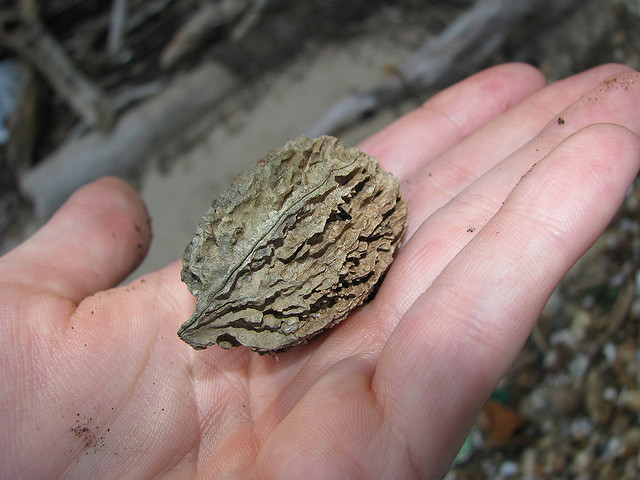Butternut
Juglans cinerea L.
Description
Juglans cinerea, commonly known as the butternut tree as well as white walnut and oilnut, is a medium-sized, deciduous hardwood tree’. Belonging to the walnut family (Juglandaceae), this tree grows to between 40 and 60 feet in height and canopy width². The average life span of the butternut is around 75 years, which is short compared to its cousin black walnut, with a life span of around 250 years³. The leaves of butternut tree have serrate margins, are alternate, are 10 – 20 inches long, and are pinnately compound with about 11 to 19 leaflets³. This species blooms in the spring showing yellow-green monoecious flowers from which the females produce a small oval nut ². The nut matures in late fall and grows either individually or in clusters of 2 to 5¹. The nut is edible and has a sweet and oily taste giving off a buttery flavor, hence their name².

Aspect of butternut tree. H. Zell³

Butternut leaf with young fruit. J. Reimer 6

Mature nut of butternut. K. Wixted, Maryland Biodiversity Project 7
Distribution
Butternut is native to most states in the northeastern region of the U.S. as well as New Brunswick, southern Ontario, and Quebec 5 . The species ranges as far south as North Carolina and Tennessee. In Maryland, Juglans cinerea is found mostly in the western counties where mountainous regions are common but has also been recorded in Baltimore 7. Butternut grows best in moist soils with good drainage and do well in higher elevations’. The climate needed for butternut trees the grow varies widely and the species is considered “winter-hardy”.
:max_bytes(150000):strip_icc()/Juglans_cinerea_range_map_1-58e6e4ce5f9b58ef7e2cea85.png)
Native range of butter nut 8
Wildlife Importance
Many animals enjoy eating the nut produced by butternut including deer, squirrels, and other rodents ³. Insects such as beetles, borers, and caterpillars eat other parts of the tree ¹. Juglans cinerea, like black walnut, releases a chemical called juglone that inhibits other plant life near such as rhododendrons and azaleas ³.
Economic Importance
Many New England residents enjoy using the nuts of Juglans cinerea to make sweet maple-butternut candy¹. The inner bark of the is used in some medicines treating conditions such as skin diseases and constipation 9. Small amounts of the wood is used for cabinetry and woodwork ¹.
Threats
Across its native range Juglans cinerea is on the decline because of a fungal disease called butternut canker (Sirococcus clavigignenti-juglandacearum) which is specific to butternut and is almost always fatal². This disease causes stems and branches to die and spreads through rainwater¹. The butternut is also susceptible to more common issues such as blight, pests, common grackle, and storm/fire damage ³. As with many plants, the butternut tree is of course susceptible to climate change, deforestation, and pollution. Butternut is also over-harvested for its commercial purpose involving syrup, nuts, and wood for cabinets and furniture². There are also a variety of pests that attack and distress the growth of the tree itself, most commonly the butternut curculio (Conotrachelus juglandis) and the common grackle, which destroys young stems and immature fruit stunting the growth of the tree 1,3.
Interesting Facts
- The genus name Juglans comes from the Latin names jovis meaning of Jupiter and glans meaning an acorn². The species name cinerea translates to gray referring to the color of the bark³.
- This tree has been placed on the endangered species list in Canada and considered vulnerable or threatened in many U.S. states3. In Maryland it is listed as State Rare 7.
- The butternut tree can be grown in Hardiness Zones 3 though 4 5.
- Confederate soldiers were often nicknamed ‘butternuts’ because their grey colored uniforms matched the coloring created from homemade butternut dye 6.
- They also produce a strong staining pigment which can damage skin as well as clothes³ .
References
- USDA Forest Service Silvics, Vol. 2, Hardwoods: Jugulars cinerea
- Missouri Botanical Garden: Jugulars cinerea
- North Carolina State Extension: Jugulars cinerea
- https://www.arborday.org/trees/treeguide/TreeDetail.cfm?ItemID=803
- Purdue Extension Forestry and Natural Resources: Identification of butternuts and butternut hybrids
- SelecTree. UFEI. “Juglans cinerea Tree Record.” 1995-2023. Cal Poly State University, San Luis Obispo.
- Maryland Biodiversity Project: Butternut
- Tree Hugger: Butternut, a common tree in North America
- WebMD: Butternut–uses., side effects and more.
Contributed by A. Perise and B. Layoff
